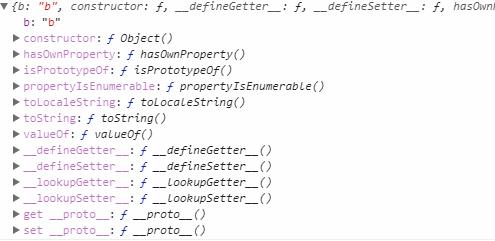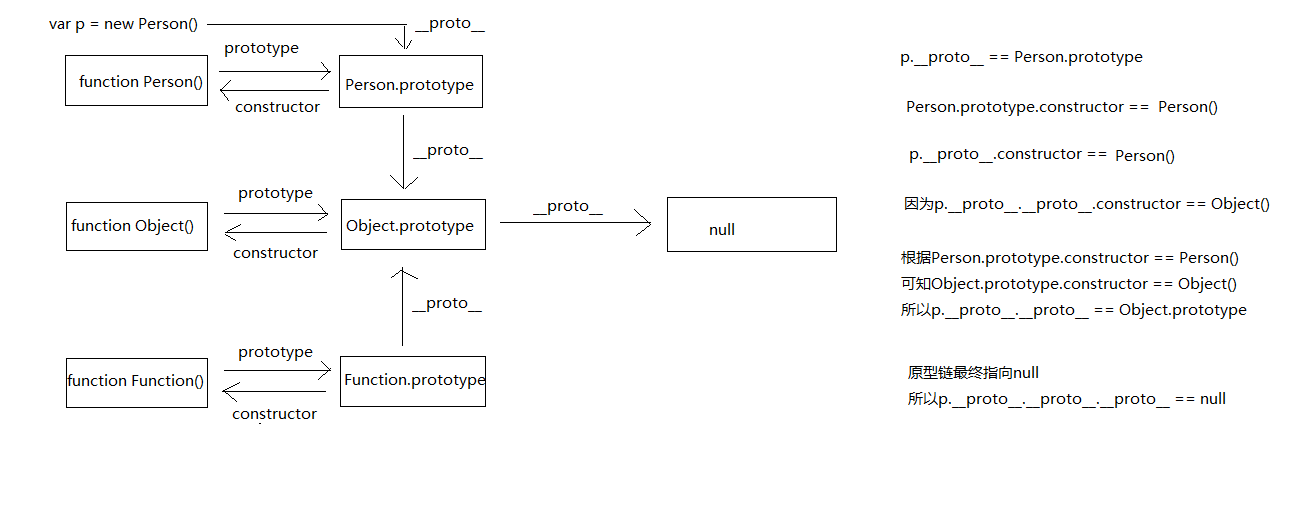JS原型与原型链理解
一,函数对象
所有引用类型(函数,数组,对象)都拥有__proto__属性(隐式原型)
所有函数拥有prototype属性(显式原型)(仅限函数)
原型对象:拥有prototype属性的对象,在定义函数时就被创建
二,构造函数
先复习下构造函数
- //创建构造函数
- function Word(words){
- this.words = words;
- }
- Word.prototype = {
- alert(){
- alert(this.words);
- }
- }
- //创建实例
- var w = new Word("hello world");
- w.print = function(){
- console.log(this.words);
- console.log(this); //Person对象
- }
- w.print(); //hello world
- w.alert(); //hello world
print()方法是w实例本身具有的方法,所以w.print()打印hello world;alert()不属于w实例的方法,属于构造函数的方法,w.alert()也会打印hello world,因为实例继承构造函数的方法。
实例w的隐式原型指向它构造函数的显式原型,指向的意思是恒等于 w.__proto__ === Word.prototype
当调用某种方法或查找某种属性时,首先会在自身调用和查找,如果自身并没有该属性或方法,则会去它的__proto__属性中调用查找,也就是它构造函数的prototype中调用查找。所以很好理解实例继承构造函数的方法和属性:
w本身没有alert()方法,所以会去Word()的显式原型中调用alert(),即实例继承构造函数的方法。
三,原型和原型链
- Function.prototype.a = "a";
- Object.prototype.b = "b";
- function Person(){}
- console.log(Person); //function Person()
- let p = new Person();
- console.log(p); //Person {} 对象
- console.log(p.a); //undefined
- console.log(p.b); //b
想一想p.a打印结果为undefined,p.b结果为b
解析:
p是Person()的实例,是一个Person对象,它拥有一个属性值__proto__,并且__proto__是一个对象,包含两个属性值constructor和__proto__
- console.log(p.__proto__.constructor); //function Person(){}
- console.log(p.__proto__.__proto__); //对象{},拥有很多属性值
我们会发现p.__proto__.constructor返回的结果为构造函数本身,p.__proto__.__proto__有很多参数
我们调用constructor属性,p.___proto__.__proto__.constructor得到拥有多个参数的Object()函数,Person.prototype的隐式原型的constructor指向Object(),即Person.prototype.__proto__.constructor == Object()
从p.__proto__.constructor返回的结果为构造函数本身得到Person.prototype.constructor == Person()所以p.___proto__.__proto__== Object.prototype
所以p.b打印结果为b,p没有b属性,会一直通过__proto__向上查找,最后当查找到Object.prototype时找到,最后打印出b,向上查找过程中,得到的是Object.prototype,而不是Function.prototype,找不到a属性,所以结果为undefined,这就是原型链,通过__proto__向上进行查找,最终到null结束
- console.log(p.__proto__.__proto__.__proto__); //null
- console.log(Object.prototype.__proto__); //null
- //Function
- function Function(){}
- console.log(Function); //Function()
- console.log(Function.prototype.constructor); //Function()
- console.log(Function.prototype.__proto__); //Object.prototype
- console.log(Function.prototype.__proto__.__proto__); //NULL
- console.log(Function.prototype.__proto__.constructor); //Object()
- console.log(Function.prototype.__proto__ === Object.prototype); //true
四、 总结:
1.查找属性,如果本身没有,则会去__proto__中查找,也就是构造函数的显式原型中查找,如果构造函数中也没有该属性,因为构造函数也是对象,也有__proto__,那么会去它的显式原型中查找,一直到null,如果没有则返回undefined
2.p.__proto__.constructor == function Person(){}
3.p.___proto__.__proto__== Object.prototype
4.p.___proto__.__proto__.__proto__== Object.prototype.__proto__ == null
5.通过__proto__形成原型链而非protrotype
最后附上一张图,大家阅读完之后,看图应该可以很容易理解
原文:https://blog.csdn.net/yucihent/article/details/79424506







